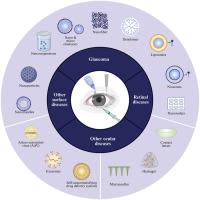用于眼部给药的热反应性水凝胶的最新进展:材料、机制和临床潜力
IF 4.9
3区 医学
Q1 PHARMACOLOGY & PHARMACY
Journal of Drug Delivery Science and Technology
Pub Date : 2025-09-17
DOI:10.1016/j.jddst.2025.107537
引用次数: 0
摘要
热反应性水凝胶的最新进展通过为持续和靶向治疗提供智能,非侵入性和患者依从性的平台,彻底改变了眼部药物输送。本文综述了热反应性水凝胶在干眼综合征、青光眼、葡萄膜炎等常见眼病治疗中的研究进展及应用。这些水凝胶在生理温度下经历溶胶到凝胶的转变,使眼部给药时能够原位凝胶化。其潜在机制增加了药物停留时间,并使药物在作用部位的释放受到控制。配方利用天然聚合物如壳聚糖、明胶和透明质酸和合成聚合物如poloxamers、PNIPAM和peg为基础的系统,每种都有助于生物相容性、生物降解性和对温度刺激的响应性。这些水凝胶的关键特性,如温度敏感相变、药物释放控制和高生物相容性,使其成为传统滴眼液的优越替代品。其好处包括减少给药频率,减少全身吸收,提高药物的生物利用度。最近的创新集中在可持续水凝胶合成,新型聚合物复合材料的掺入,以及改进的药物包封技术。尽管取得了重大进展,但挑战依然存在,包括合成成分的潜在细胞毒性、生产的可扩展性以及实现精确的药物释放动力学。未来的发展方向是优化配方稳定性,探索刺激联合响应系统,并将纳米技术整合到精准医疗中。这篇综述强调了热反应性水凝胶在眼科治疗中的变革潜力,并强调了它们作为下一代智能眼科药物输送系统基石的前景。本文章由计算机程序翻译,如有差异,请以英文原文为准。

Recent advances in thermo-responsive hydrogels for ocular drug delivery: Materials, mechanisms, and clinical potential
Recent advancements in thermo-responsive hydrogels have revolutionized ocular drug delivery by offering a smart, non-invasive, and patient-compliant platform for sustained and targeted therapy. This review comprehensively discusses the development and application of thermo-responsive hydrogels in the treatment of prevalent ocular diseases such as dry eye syndrome, glaucoma, and uveitis. These hydrogels undergo sol-to-gel transitions at physiological temperatures, enabling in situ gelation upon ocular administration. The underlying mechanism enhances drug residence time and enables controlled drug release at the site of action. Formulations leverage both natural polymers such as chitosan, gelatin, and hyaluronic acid and synthetic polymers like poloxamers, PNIPAM, and PEG-based systems, each contributing to biocompatibility, biodegradability, and responsiveness to temperature stimuli. Key properties such as temperature-sensitive phase transition, controlled drug release, and high biocompatibility position these hydrogels as superior alternatives to conventional eye drops. The benefits include reduced dosing frequency, minimized systemic absorption, and enhanced drug bioavailability. Recent innovations focus on sustainable hydrogel synthesis, incorporation of novel polymer composites, and improved drug encapsulation techniques. Despite significant progress, challenges remain, including potential cytotoxicity of synthetic components, scalability of production, and achieving precise drug release kinetics. Future directions aim to optimize formulation stability, explore stimuli-combination responsive systems, and integrate nanotechnology for precision medicine. This review underscores the transformative potential of thermo-responsive hydrogels in ocular therapeutics and highlights their promise as a cornerstone in the next generation of smart ophthalmic drug delivery systems.
求助全文
通过发布文献求助,成功后即可免费获取论文全文。
去求助
来源期刊
CiteScore
8.00
自引率
8.00%
发文量
879
审稿时长
94 days
期刊介绍:
The Journal of Drug Delivery Science and Technology is an international journal devoted to drug delivery and pharmaceutical technology. The journal covers all innovative aspects of all pharmaceutical dosage forms and the most advanced research on controlled release, bioavailability and drug absorption, nanomedicines, gene delivery, tissue engineering, etc. Hot topics, related to manufacturing processes and quality control, are also welcomed.

 求助内容:
求助内容: 应助结果提醒方式:
应助结果提醒方式:


